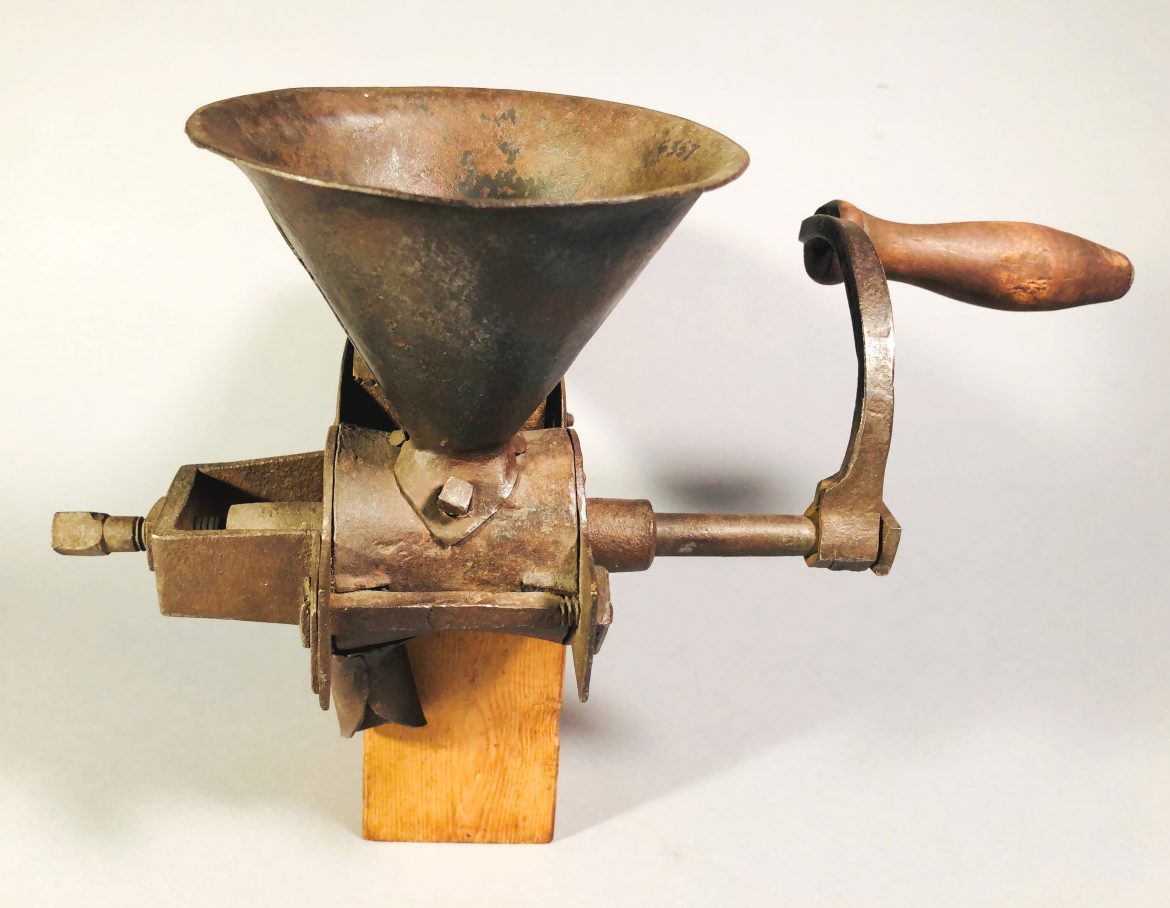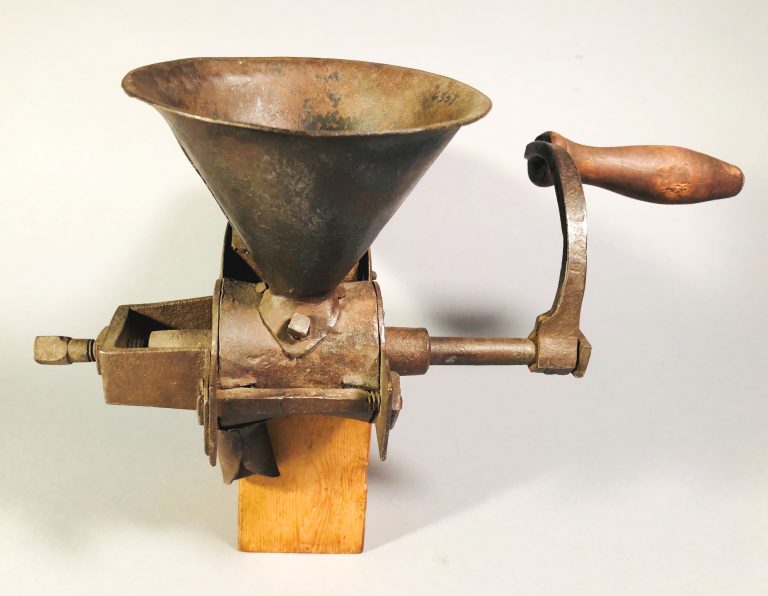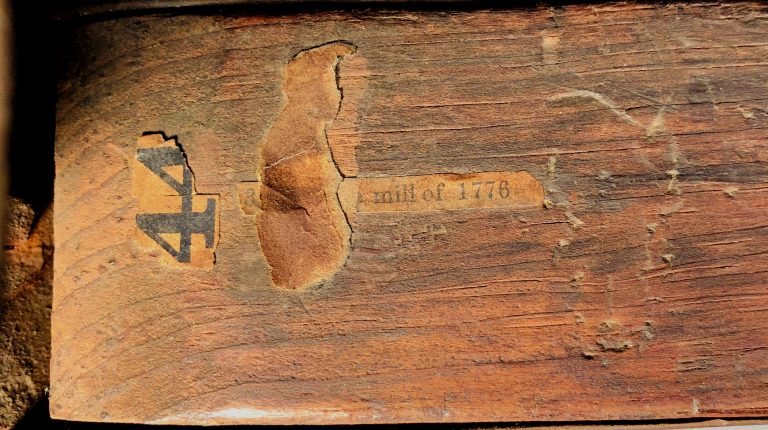
Coffee Mill, Church Family, Canterbury, NH, 1776, Shaker Museum: 1953.6357.1 Staff photograph.
The Shakers have had a relationship with coffee throughout their history – from the object at hand, a coffee mill thought to date from 1776, to the large pot of coffee kept brewing in the Sabbathday Lake dining room for the current Shaker family, their staff, and guests in Maine. Though the world’s habit of drinking coffee only dates to the 15th century, by the mid-16th century the practice was […]
The Shakers have had a relationship with coffee throughout their history – from the object at hand, a coffee mill thought to date from 1776, to the large pot of coffee kept brewing in the Sabbathday Lake dining room for the current Shaker family, their staff, and guests in Maine. Though the world’s habit of drinking coffee only dates to the 15th century, by the mid-16th century the practice was well established in England and by 1774, when Shakers landed in Lower Manhattan, coffee had been replacing beer as the breakfast beverage of choice in the Colonies for nearly a century. Lower Manhattan was well on its way to being New York’s “Coffee District.” Coffee beans, imported from the Caribbean, were sold green and were home-roasted in pans over a stove or open fire – often blackening the ceilings of kitchens as cooks struggled to control the process. Roasted beans were then ground in special mills or crushed in a mortar with a pestle. Eighteenth century recipes for making coffee vary considerable, but since most of them involve boiling ground coffee in water, they generally include a method of removing the coffee grounds – clarifying the coffee with a fining agent – egg white, gelatin, or isinglass, the same agents used for fining wine.

Coffee Mill, Church Family, Canterbury, NH, 1776, Shaker Museum: 1953.6357.1 Staff photograph.
The 1776 coffee mill, one of five coffee mills in the Shaker Museum’s collection, other than being one of the oldest known pieces used by the Shakers, has a special history of its own. The mill has two labels pasted on it. One reads, “3 [illegible] e mill of 1776” and the other, merely the numeral “44.” When it was cataloged by the Museum in 1953, the mill also had a piece of paper tied to it that read, “44. Coffee Mill. This was used in 1792 and was thought to be excellent.” These labels had been affixed to the mill by Elder Henry Clay Blinn (1824-1905). In addition to being a spiritual leader of the Church Family as an Elder or member of the Ministry for 61 years, and practicing the trades of tailoring, printing, cabinetmaking, tinsmithing, teaching, beekeeping, publishing, and repairing the family’s teeth, around 1860 he started a “museum.” His collection, defined by his commitment to teaching and recording Shaker history, included more than 250 artifacts. Elder Henry added to the collection until the time of his death and the family continued adding appropriate items into the 1920s. In 1917 a “Key to Shaker Museum” was recorded. It includes an entry for number 44: “Coffee mill of 1776. Used in 1792, and thought to be excellent.” Although it is unclear how the date 1776 became associated with the coffee mill, its use in 1792 dates to the founding year of the Shaker Village at Canterbury, NH. The mill itself is clearly of a very early manufacture – the pieces from which it was assembled were clearly hand forged and machined to the point and it may well be a one of a kind piece.

Coffee Mill (detail of labels), Church Family, Canterbury, NH, 1776, Shaker Museum: 1953.6357.1 Staff photograph.
The Shakers’ relationship with coffee is conveniently summarized in the “History of the Church of Mt. Lebanon, N. Y. No. 8,” published in the December, 1890 issue of their monthly magazine The Manifesto. The author writes:
The use of foreign tea and coffee has been dismissed several times, but after an interval of a few months has returned in all its freshness, to its former place on the table. During these terms of departure the family has used instead, a tea made of sage, of strawberry leaves, cross-wort or of Liberty tea*, and a coffee of burnt crust or rye** or of the root of the Avens. The injurious effects of drinking strong tea or coffee have often been discussed, and Believers have always considered it wrong to become the slave of any habit.
This history points out that throughout Shaker history there were movements to reduce or eliminate the use of coffee. These periods were generally related to health concerns or an effort to control bad habits – as they have the power to distract one from the simple purity sought after by Shakers. An individual’s choice to use coffee, tobacco, or alcohol also has a tendency to excite disunion within the community. Around 1840, during the period of heightened spiritual communications known as the Era of Manifestations, there was a particularly strong injunction against eating pork, drinking alcohol, smoking, and drinking tea and coffee. In a manuscript in the Shaker Museum’s collection titled, “Copy of book brought by Father William [Lee] and Father James [Whittaker], and given to the Elders of the First Order, April 21st 1841,” a spiritual communication from Father William asks the “middle aged and young in the Church” to “Take up every cross that is presented to you, and be faithful with your hands, to do all you are able, and indulge not yourselves in any way, eating, drinking or sleeping, more than is really needful and necessary for the support of your natural bodies.”
As for health, the pros and cons of coffee were often presented in the pages of The Manifesto. For example, an essay, reprinted from The Atlanta Constitution in the September, 1897 issue, sounds a stern, sarcastic warning:
Too Much Coffee. Do you want to be blind? Drink coffee. Drink lots of it. Drink it with breakfast, lunch and dinner, and drink it between meals. Drink it when you get up in the morning and drink it before you go to bed at night. Drink it long and strong, and keep it up, and by and by you will be as sightless as the proverbial bat.
As mentioned above, the Shakers have had a relationship with coffee through their whole history – sometimes a favorable relationship – sometimes, not so much, but it always went beyond that pleasant morning smell and the simulation it gives one to move into the day’s work.
—
* Liberty Tea – or more properly teas or tisanes – are brewed herbal mixes that, while still popular, became so after the Boston Tea Party of 1773 made it unpatriotic to drink tea imported from England. Liberty tea could be a mixture of any number of herbs, barks, and dried fruits. A common recipe included equal parts of sweet goldenrod, betony, clover, and New Jersey tea (Redroot).
** On December 10, 1861, a South Union journal recorded that Union Army Captain Taylor arrived at the Shaker settlement and called for breakfast for 250 of his mounted cavalry. The Shakers supplied the men with breakfast, “the drink was Sassafras tea & rye coffee – the soldiers jocosely called it Jeff Davis coffee.” Canterbury Sister Lavina Clifford included rye coffee in her collection of recipes: “First wash the rye, then boil it until it begins to crack; drain, and dry it in an oven. Brown it, as you would other coffee; grind it and when making the coffee clarify with an egg in the usual way. Put in plenty of cream & loaf sugar & it goes well.” Sister Lavina Clifford, “Receipt Book,” Church Family, Canterbury, NH, Shaker Museum: 1960.12737.1, p.25].
Thank you so much for this wonderful story, about coffee, the Shakers and interesting history.
How refreshing.
I appreciate the scholarship.
One of my earliest memories is the aroma of coffee: every Saturday morning our local grocery store would roast a supply for the sales of the coming week. The fragrance permeated the streets, back yards and stairwells of our neighborhood.